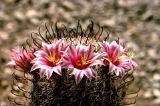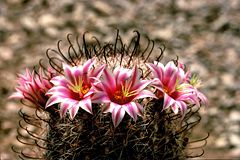
Fishhook cactus
Encyclopedia

Species
In biology, a species is one of the basic units of biological classification and a taxonomic rank. A species is often defined as a group of organisms capable of interbreeding and producing fertile offspring. While in many cases this definition is adequate, more precise or differing measures are...
of the genus
Genus
In biology, a genus is a low-level taxonomic rank used in the biological classification of living and fossil organisms, which is an example of definition by genus and differentia...
Mammillaria
Mammillaria
The genus Mammillaria is one of the largest in the cactus family , with currently 171 known species and varieties recognized. Most of the mammillarias are native to Mexico, but some come from the southwest USA, the Caribbean, Colombia, Venezuela, Guatemala and Honduras.The first was described by...
. They are small cacti
Cacti
-See also:* RRDtool The underlying software upon which Cacti is built* MRTG The original Multi Router Traffic Grapher from which RRDtool was "extracted".* Munin -External links:******...
, usually growing up to 6-7 inches (20 cm) high, and are shaped similar to a barrel cactus
Barrel cactus
Barrel cacti are classified into the two genera Echinocactus and Ferocactus, both of which are found in the Southwest Desert of North America. Their pineapple-shaped fruits can be easily removed but are not recommended for eating. The barrel cactus may reach over a metre in height. Its ribs are...
. They are not to be confused with the Fishhook Barrel Cactus (Ferocactus wislizenii) of the Sonoran
Sonoran Desert
The Sonoran Desert is a North American desert which straddles part of the United States-Mexico border and covers large parts of the U.S. states of Arizona and California and the northwest Mexican states of Sonora, Baja California, and Baja California Sur. It is one of the largest and hottest...
and Chihuahuan Desert
Chihuahuan Desert
The Chihuahuan Desert is a desert, and an ecoregion designation, that straddles the U.S.-Mexico border in the central and northern portions of the Mexican Plateau, bordered on the west by the extensive Sierra Madre Occidental range, and overlaying northern portions of the east range, the Sierra...
s.
Good places to see "fishhook" Mammillaria are the Sonoran Desert
Sonoran Desert
The Sonoran Desert is a North American desert which straddles part of the United States-Mexico border and covers large parts of the U.S. states of Arizona and California and the northwest Mexican states of Sonora, Baja California, and Baja California Sur. It is one of the largest and hottest...
on the U.S. - Mexico border, and the Mesa Verde National Park
Mesa Verde National Park
Mesa Verde National Park is a U.S. National Park and UNESCO World Heritage Site located in Montezuma County, Colorado, United States. It was created in 1906 to protect some of the best-preserved cliff dwellings in the world...
.
Notable species
The genus Mammillaria also contains "pincushion" and other cacti.- Mammillaria barbata – Green Fishhook Cactus
- Mammillaria dioicaMammillaria dioicaMammillaria dioica, also called the strawberry cactus, California fishhook cactus, strawberry pincusion or fishhook cactus, is a cactus species of the genus Mammillaria found in California and northwestern Mexico, including Baja California and the state of Sonora.The plant possesses short, firm...
– California Fishhook Cactus, Strawberry Cactus - Mammillaria grahamii – Arizona Fishhook Cactus
- Mammillaria grahamii var. oliviae – Pitahayita
- Mammillaria tetrancistraMammillaria tetrancistraMammillaria tetrancistra is a species of fishhook cactus known by the common name common fishhook cactus. It is native to the Mojave and Sonoran Deserts of northern Mexico and the southwestern United States, where it grows in a variety of desert habitat types.-Description:This cactus generally has...
– Common Fishhook Cactus - Mammillaria thornberi – Clustered Fishhook Pincushion

